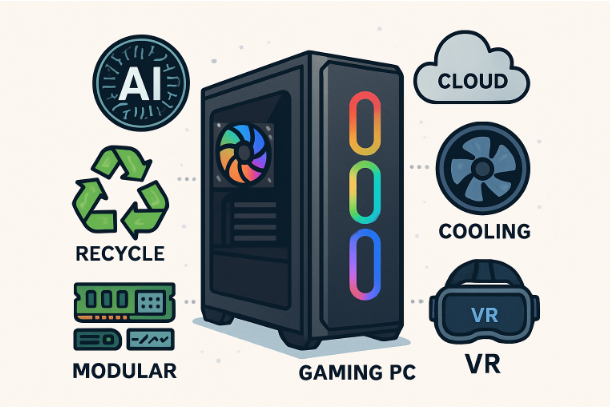Key Takeaways
- AI integration optimizes gaming performance and personalizes user experiences.
- Cloud gaming is making high-quality games more accessible without needing high-end hardware.
- Sustainable practices are becoming a priority in gaming PC manufacturing.
- Advanced cooling systems are essential for maintaining optimal performance in powerful gaming rigs.
- Customization and modularity allow gamers to tailor their systems to specific needs.
Introduction
From casual hobbyists to competitive esports athletes, gaming has become a multi-billion-dollar global industry influencing entertainment, technology, and culture. Powerful hardware, cutting-edge graphics, and lightning-fast connectivity have become the standard for delivering seamless, immersive experiences. With increasing demand for performance and sustainability, manufacturers are reimagining what gaming systems can achieve. The world of gaming PCs is seeing exponential change as new technologies push the boundaries of what’s possible. Enthusiasts and serious gamers always search for high-performance gaming PCs that offer raw speed and more innovative, sustainable, and immersive experiences. As the industry evolves, players are experiencing innovations that transform gameplay, accessibility, and environmental impact in equal measure.
Understanding the latest advancements is crucial for those building or buying their next rig. Today’s trends center on optimizing performance, expanding accessibility through new platforms, and integrating emerging tech like AI and VR to deliver gameplay that’s smoother, smarter, and more engaging than ever before.
AI Integration Enhances Performance
Artificial Intelligence (AI) is at the forefront of gaming PC innovation. Modern systems utilize AI-driven optimization tools that dynamically adjust system resources, ensuring top-tier performance during intense gaming moments. For example, AI can intelligently allocate CPU and GPU power, adjust fan speeds, or even overclock components on the fly. This boosts frame rates and reduces stutter, creating a seamless gaming experience. According to the Financial Times, these advancements lead to more reliable and consistent performance across various gaming titles.
Cloud Gaming Expands Accessibility
Cloud gaming platforms are transforming how people experience games by eliminating the necessity for expensive, top-of-the-line hardware. Instead, games run on powerful remote servers and stream directly to your device, whether a PC, smartphone, or tablet. This is democratizing gaming, as more people than ever before can access AAA titles without the requirement for costly upgrades. Services like Xbox Cloud Gaming and NVIDIA GeForce NOW are already paving the way, with the market expected to grow in the coming years as broadband infrastructure improves globally.
Sustainable Practices in Manufacturing
As environmental awareness grows, gaming PC manufacturers are shifting focus toward sustainability. Newer systems are integrating energy-efficient power supplies, low-power CPUs, and recyclable materials in their chassis and packaging. Eco-friendly components can deliver high performance while reducing the carbon footprint associated with manufacturing and operating gaming rigs. Leading brands are also investing in renewable energy and circular economy models to minimize their environmental impact further, a trend set to become standard across the industry.
Advanced Cooling Systems for Optimal Performance
With increases in processing power comes the challenge of effectively managing heat. Innovative cooling solutions are critical for maintaining stability and longevity in high-performance gaming PCs. Leading manufacturers are implementing liquid cooling pipes, vapor chambers, and intelligent fan systems that respond in real-time to temperature spikes during heavy usage. These systems help prevent thermal throttling, which can severely impact game performance, and ensure that even intensive marathons run smoothly for hours.
Customization and Modularity
Gamers demand more control over their hardware than ever, with modern systems reflecting an increased focus on upgradability and personalized aesthetics. Modular designs allow users to swap out major components, such as graphics cards, storage, and RAM, without needing technical expertise or specialized tools. Customizable RGB lighting systems, transparent cases, and cable management options let users design rigs that are as visually impressive as powerful. This shift makes PC gaming more accessible and user-friendly, fostering a robust DIY culture within the gaming community.
Integration of Virtual and Augmented Reality
Virtual Reality (VR) and Augmented Reality (AR) are creating new, immersive ways for players to interact with digital worlds. The latest VR headsets and AR features introduce advanced motion tracking, ultra-fast refresh rates, and higher resolutions, blurring the line between game and reality. As game developers craft richer, more interactive environments, VR and AR are becoming essential in delivering fully immersive gaming experiences. For a closer look at the influence of immersive technology on modern gaming, check out this overview on AP News.
Emergence of AI-Driven NPCs and Dynamic Storytelling
Game developers harness AI to design non-player characters (NPCs) with adaptive behaviors that respond uniquely to each player’s choices and play style. This deepens the sense of immersion and ensures that every playthrough can offer new experiences. AI-driven storytelling is also making narratives more complex and interactive. Player decisions influence story arcs, character relationships, and even the game world itself, providing dynamic narratives that were previously impossible with scripted events alone. These developments set a new standard for interactivity and engagement in modern games.
Conclusion
The gaming PC landscape is evolving remarkably, fueled by innovations that redefine how players design, upgrade, and engage with their systems. Artificial intelligence optimizes in-game performance, adjusting real-time settings for smoother gameplay. Cloud gaming platforms are breaking accessibility barriers, allowing high-end experiences without requiring top-tier local hardware. Sustainable design is gaining traction, with energy-efficient components and recyclable materials reducing environmental impact. Advanced cooling solutions—from liquid systems to cutting-edge airflow designs—enable higher performance without overheating. Personalized modular builds let gamers swap parts easily, tailoring rigs to evolving needs. Meanwhile, immersive VR and AR tools transform interaction, while next-generation storytelling blurs the line between games and cinematic experiences. Staying informed on these trends ensures gamers can fully embrace the future of interactive entertainment, enhancing both performance and immersion.



